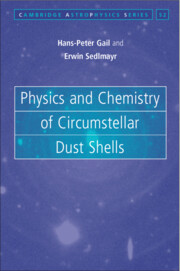Book contents
- Frontmatter
- Contents
- Preface
- Part I Setting the Stage
- Part II Theoretical Description of Circumstellar Dust Shells
- 3 Theory of Circumstellar Dust Shells
- 4 Energy Equation for Matter
- 5 Radiative Transfer
- 6 Interaction between Gas and Dust Particles
- 7 Extinction by Dust Grains
- 8 Approaches to the Temperature Equations
- 9 Chemistry in Thermodynamic Equilibrium
- 10 Gas-Phase Chemical Composition
- 11 Gas-Solid Chemical Equilibria
- 12 Growth of Dust Grains
- 13 Formation of Seed Nuclei
- 14 Moment Equations
- Part III Applications
- Part IV Appendices
- Bibliography
- Index
- Miscellaneous Endmatter
12 - Growth of Dust Grains
from Part II - Theoretical Description of Circumstellar Dust Shells
Published online by Cambridge University Press: 18 December 2013
- Frontmatter
- Contents
- Preface
- Part I Setting the Stage
- Part II Theoretical Description of Circumstellar Dust Shells
- 3 Theory of Circumstellar Dust Shells
- 4 Energy Equation for Matter
- 5 Radiative Transfer
- 6 Interaction between Gas and Dust Particles
- 7 Extinction by Dust Grains
- 8 Approaches to the Temperature Equations
- 9 Chemistry in Thermodynamic Equilibrium
- 10 Gas-Phase Chemical Composition
- 11 Gas-Solid Chemical Equilibria
- 12 Growth of Dust Grains
- 13 Formation of Seed Nuclei
- 14 Moment Equations
- Part III Applications
- Part IV Appendices
- Bibliography
- Index
- Miscellaneous Endmatter
Summary
Theoretical Description of Growth Processes
The basic process for the growth of a dust grain is the collision of a species from the gas phase with the surface of a dust grain. In some fraction of such collisions, translational energy of the gas-phase particle is consumed by exciting vibrational states of the solid, and the particle is captured into a bound state of a surface oscillator. The particle is then bound to the surface of the solid. This process is called adsorption; it is depicted schematically in Figure 12.1. If the particle is not adsorbed, it is scattered back into the gas phase. As a result of adsorption, the surface of any solid embedded in a gaseous environment always is covered with various kinds of particles from the gas phase (also called adatoms).
The freshly adsorbed particles initially are only weakly bound to the surface because adsorption occurs only rarely at a site where the incoming particle immediately forms a strong chemical bond with surface atoms of the solid. In most cases the particle is bound by weak van der Waals forces (at low temperatures) or electrostatic interactions between charged and electrostatically polarizable atoms or molecular groups.
The atoms at the surface of the solid are in a state of permanent vibration due to the thermal excitation of lattice vibrations. By interaction with the vibrating substrate, the adsorbed particles are excited to vibrations relative to the particles at the surface of the solid.
- Type
- Chapter
- Information
- Physics and Chemistry of Circumstellar Dust Shells , pp. 332 - 396Publisher: Cambridge University PressPrint publication year: 2013

